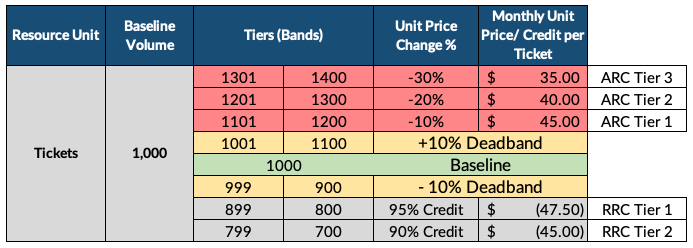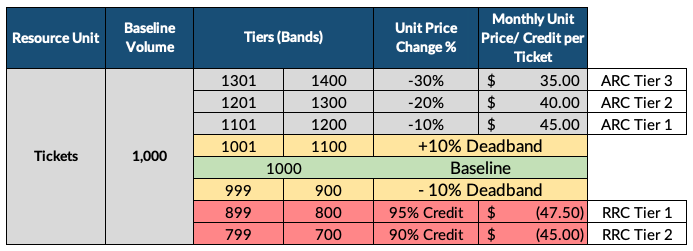- Greg Hall
- Reading Time: 4 minutes

Managing Change with Deadband, ARC, and RRC Metrics
A best practice to address changes to your scope of outsourced services is to establish price points for each resource unit metric (e.g., tickets, servers, desktops, endpoints, etc.) that are appropriate for your beginning (baseline) volumes. With established metrics that provide cost certainty to your baseline quantities, you can then formalize the process by which you will manage fluctuations in volume above and below that baseline throughout a term.
Here are the three ways you can manage modifications to your baseline by leveraging your beginning quantities.
Establish a Negotiated Deadband
For those who may be unfamiliar with the term, a deadband is the range of deviation in actual quantity above or below your baseline where there is no added cost to support this change in volume. Deadbands are most often expressed as a percentage. A typical deadband is 10%.
Here is an example of a situation with a 10% deadband:
- Metric is tickets per month.
- Baseline is 1,000 tickets per month.
- Fixed cost of services is $50,000 per month for tickets.
If the deadband is 10%, the actual ticket volume can fluctuate from 900 tickets to as high as 1,100 tickets with no change in fees for the month (still $50,000).
What is an ARC?
An Additional Resource Charge (ARC) is the cost you would pay for any additional units (e.g., tickets) that your provider supported for a given month that is above the baseline, or above the baseline plus deadband if a deadband was negotiated. ARCs are expressed as a per unit (e.g., ticket) charge added to your monthly bill for units above agreed-to limits. ARCs should cost less the further you deviate from your baseline and are typically represented in bands where each band represents a range of quantities above the baseline with a unit price for each range.
The table below shows an example of this with the ARC tiers highlighted in red.

- Metric is tickets per month.
- Baseline is 1,000 tickets per month.
- Fixed cost of services is $50,000 per month for tickets.
- Deadband is 10%.
- Actual ticket volume for the month is 1,225 tickets.
With your ARC ranges (tiers) set to decrease costs every 10% deviation from the baseline, your structure would look like this:
| ARC Tier 2 | 1,201 – 1,300 tickets | Added charge of $40.00/ticket |
| ARC Tier 1 | 1,101 – 1,200 tickets | Added charge of $45.00/ticket |
| Deadband | 1,001 – 1,100 tickets | Fixed cost ($50K) – No change |
| Baseline | 1,000 tickets | Fixed cost ($50K) |
With 1,225 tickets worked in a month, the cost would be $55,500 consisting of $50K (baseline cost), plus $0 cost for the first extra 100 tickets (deadband), plus $4,500 for tickets 1,101 – 1,200 (100 tickets X $45.00/ticket) and finally, plus $1,000 for tickets 1,201 – 1,225 (25 tickets X $40.00/ticket).
The benefit of an ARC structure is that you maintain a shared value in an increase to demand. Your provider gets an increase in revenue, and in turn, provides you a lower price point to lessen the per unit cost of your increase in volume.
What is an RRC?
A Reduced Resource Credit (RRC) is the opposite of an ARC. RRCs represent the credits you receive if your service provider supports an actual volume of tickets for a given month that is below the baseline or below the baseline plus deadband if a deadband was negotiated. RRCs are expressed as a per unit (e.g., ticket) credit to your monthly bill for unit quantities below the agreed-to limits. Lower volumes of units (e.g., tickets) supported mean less effort expended, and hence, less cost to provide support. RRC bands, like ARC bands, are intended to maintain a balance to both parties as the cost of actual services tie to actual volume. Whereas ARCs get less expensive as quantities increase, RRCs decrease as you move further below your baseline volume.
The table below shows an example of this with the RRC tiers highlighted in red.

- Metric is tickets per month.
- Baseline is 1,000 tickets per month.
- Fixed cost of services is $50,000 per month for tickets.
- Deadband is 10%.
- Actual ticket volume for the month is 725 tickets.
With your RRC ranges (tiers) set to decrease costs every 10% deviation from the baseline, your structure would look like this:
| Baseline | 1,000 tickets | Fixed cost ($50K) |
| Deadband | 999 – 900 tickets | Fixed cost ($50K) – No change |
| RRC Tier 1 | 899 – 800 tickets | Credit of $47.50/ticket |
| RRC Tier 2 | 799 – 700 tickets | Credit of $45.00/Ticket |
With 725 tickets worked in a month, the cost would be $50,000 (baseline cost), $0 cost for the first 100 tickets below the baseline (deadband), less a credit of $4,750 for falling 100 tickets below the baseline quantity, minus the deadband (100 tickets X $47.50 credit/ticket) and a credit of $3,375 for falling an additional 75 tickets below the baseline quantity, minus the deadband (75 tickets X $45.00 credit/ticket).
The benefit of an RRC structure is that you get a credit back from your fixed fee baseline cost when volumes fall below your established baseline. The credit reduces the farther you go from the baseline in fairness to the provider as the provider loses certain efficiencies and economies of scale as the volume of service decreases.
These three concepts of deadband, ARC and RRC are agreements established up front between you and your provider that allow for the effective and objective handling of fluctuations in volume associated with support agreements tied to resource unit metrics (e.g., the number of tickets, servers, desktops, mailboxes, etc.). This transparency benefits both parties, reduces administrative costs of change orders, and ensures a healthy balance of cost-to-value.
Learning to establish terms that benefit both you and your vendor is an important component to developing a strategic relationship. Contact us today to see how our expert advisors can help you establish these strategies and put them into practice.
